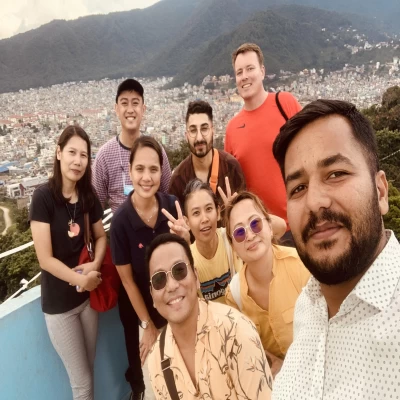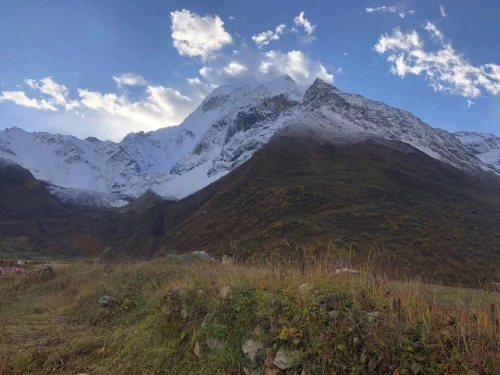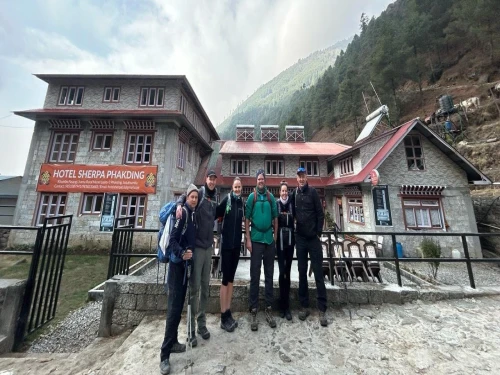About Altitude Sickness
Altitude sickness, or Acute Mountain Sickness (AMS), is one of the many issues for trekkers travelling in high-altitude areas such as the Manaslu Circuit. The thinning atmosphere becomes apparent at about 2,500 meters (8,200 feet), and decreasing oxygen levels. This low oxygen concentration can affect your ability to adapt to the altitude changes, and with that comes an array of pronounced physical symptoms that should not be neglected.
What Is Altitude Sickness?
Altitude sickness is a way in which the organism reacts to very low oxygen levels prevailing at a high altitude. Normally, it develops when one ascends too rapidly without enough time for the body to adjust. Anyone can get altitude sickness, whether young or old, male or female, fit or otherwise; predicting who will get it is possible.
For trekkers along the Manaslu Circuit, over 5,100 metres is typically attained (Larke Pass).
Hence, altitude-related illnesses are an ever-present reality awaiting precautionary measures.
Types of High Altitude Sickness
There are primary forms of altitude sickness, ranging from mild to severe:
Acute Mountain Sickness (AMS)
- This kind of sickness is a common one among the three and presents at increased elevations above 2500 metres.
- Headache, nausea, impaired consciousness, anorexia, and fatigue are some of the symptoms.
- Symptoms purport a hangover and can worsen with time if ignored early.
High Altitude Pulmonary Oedema (HAPE)
- It develops as fluid spills into the lungs and is held there.
- This condition can develop symptoms of persistent coughing, breathlessness, chest constriction, and fatigue.
- Consent of HAPE requires a quick exodus, coupled with medical treatment.
High Altitude Cerebral Oedema (HACE)
- Another damaging situation, potentially life-threatening, is where the brain swells.
- The affected will be confused and out of coordination, will hallucinate, be unable to walk, and often will fall into a deep unconscious state.
- HACE leads to an emergency that requires a swift descent and helicopter evacuation.
Why Do People Get Sick on the Manaslu Circuit?
The Manaslu region is less developed and more remote, which gives it a mix of charm and toughness. The track, which involves continuous ascents over several days with no guarantee of medical help, is also more remote.
Trekkers often have faster symptoms above 3000 meters if they go up quickly or don't give their bodies enough time to adjust. At 5160 meters, Larke La Pass is the highest point of the trip, which makes it more dangerous.
Symptoms to Watch Out For During Manaslu Circuit Trekking
As you ascend through breathtaking landscapes of the Manaslu region, the variable oxygen concentration in these high altitudes will increasingly affect your body. Altitude sickness, termed Acute Mountain Sickness (AMS), can reportedly affect anyone, irrespective of age, fitness, or trekking experience. Therefore, early recognition of its symptoms is important to prevent severe health risks and ensure that the trek remains safe.
Mild Symptoms (Typical of AMS)
- The symptoms typically start above 2,500 meters, leading people to dismiss them as typical fatigue. However, feigning ignorance can prove to be dangerous, as it can worsen with continued ascent.
- Headache. A steady headache is usually the first symptom of altitude sickness. One may have a sense of tension or pressure within the head, or even a migraine. Rest and hydration somehow do not ameliorate the pain.
- Nausea or vomiting: Most of the trekkers feel nauseated or sometimes vomit when their body is trying to adjust to less air.
- Dizziness or light-headedness, common after exertion, usually means unsteadiness or a sensation of sinking without support, somehow possible.
- Loss of Appetite: A Major sign that one starts losing interest in food suddenly without reason after a long day of trekking.
- Fatigue and Weakness: A sense of overall tiredness or being unable to move uphill with ease, even after brief rests.
- Sleep Disturbances: Difficulty in falling asleep or frequent waking at night due to sometimes abnormal breathing.
This means that all these signs signal your body that it is not acclimatising and that it deserves a time out from acclimatisation work. Alright! Get some rest. Stay hydrated. If symptoms improve, consider going back up.
Moderate to Severe Symptoms (HAPE or HACE)
- If mild AMS is left untreated, then it can turn into more serious High Altitude Pulmonary Oedema (HAPE) and High Altitude Cerebral Oedema (HACE). Life-threatening conditions are characterised by immediate descent and require medical attention.
- HAPE Symptoms (Fluid in the lungs):
- Dyspnoea with rest.
- Persistent dry cough, potentially productive of frothy or bloody sputum.
- Chest tightness or congestion.
- Cyanosis (blue-tinged lips or nails indicate low oxygen saturation).
- Extreme fatigue and inability to walk without assistance.
HACE symptoms (Swelling of the brain):
- Intense headache unrelieved by any analgesics.
- Loss of coordination (ataxia): the inability to walk a straight line.
- Disorientation with hallucinations or bizarre behaviour.
- Slurred speech or difficulty in speaking coherently.
- Drowsiness that leads to loss of consciousness.
If a fellow trekker starts showing some of these signs, he is in a medical emergency and needs immediate descent, which is the only effective treatment, with oxygen and helicopter evacuation if deemed necessary.
Factors Increasing the Risk of Altitude Sickness
Not only those advanced in age or health, but just about everyone stands a chance of getting sick at high altitudes. There are, however, specific factors that generally set one at a higher probability of developing the symptoms, especially during high-altitude treks such as the Manaslu Circuit. Realizing the importance of these factors lies in taking active measures in preparation for a safe trekking experience.
Rapid Ascents Without Proper Acclimatization
Should rapid ascent without proper acclimatization result in altitude sickness, this would firmly establish the condition as one of the most common causes of illness at high altitudes. Pushing oneself too far and climbing too high, too fast leaves less opportunity for acclimatization, and conditions such as acute mountain sickness (AMS) and, in a few cases, quite often fatal ones such as HAPE (high-altitude pulmonary edema) or HACE (high-altitude cerebral edema) can set in.
Manaslu Circuit Example: Trekkers often experience altitude sickness as a result of skipping the acclimatization days between Namrung, Samagaun, and Samdo.
Dehydration
At altitude, the loss of moisture from your body occurs quickly via respiration and perspiration processes. The combination of cold and dry air with some amount of physical exertion can sneak dehydration into your body. As dehydration thickens your blood, it decreases the amount of oxygen being supplied to tissues, thereby worsening all unnecessary altitude sickness symptoms. A common misconception among trekkers is that they think they should drink less water at higher altitudes, especially when the temperature drops and thirst is less noticeable.
Tips: Drink at least 3–4 liters of water each day and pay attention to your urine color; darker means dehydration.
Overexertion
Excessive physical activity in an ascent may be one of your bigger challenges, and an increase in the oxygen demand. Now, it's important to consider that excessive physical activity can add stress to your system as it adjusts to lower oxygen levels. Climbing steep trails, racing ahead, or carrying heavy loads may also further limit acclimatization options and thus put you at higher risk of altitude-related problems.
Tips: Be slow and steady, especially over 3,000 meters. Trekking is not a race, and walk high, sleep low, and conserve your energies.
Lack of Prior Altitude Experience
Such trekkers are more susceptible to symptoms if they have not previously been at high altitude. While experience with high-altitude trekking does not guarantee protection from altitude sickness, they tend to be more aware of the warning signs and acclimatization strategies.
Tips: If it's your first time over 4,000 meters, take some additional precautions and do some short acclimatization hikes before trying the Manaslu Circuit.
Pre-existing Medical Conditions
Several medical conditions may increase the possibility of some complications at high altitudes. Those with respiratory diseases (e.g., asthma), diseases of the cardiovascular system, sleep apnea, and even less oxygen-carrying capacity due to anemia make acclimatization more difficult. They are further increased by being extreme.
Tips: You should always have a consultation with medical professionals before trekking if you have chronic health issues and are carrying medication.
Depressed Nutrition and Poor Diet
Very Much Nutrition in the Proper Order. High altitudes burn calories and require more energy to bear even basic functions; a bad diet will weaken your body's resistance and increase fatigue, which contributes to altitude sickness.
Tips: Eat frequently, consuming many complex carbohydrates, as well as alcohol or sleeping pills, which depress breathing.
Understanding these risk factors is one important step in prevention. There is a good chance you will escape the dreaded altitude sickness as you prepare your body and mind to respect the limits that nature sets, thus allowing you to enjoy this awe-inspiring walk into the Manaslu.
Best Tips to Prevent Altitude Sickness on the Manaslu Circuit
Altitude sickness, or acute mountain sickness (AMS), can cause a lot of discomfort while trekking in high-altitude areas such as the Manaslu Circuit. The good thing is that with a few precautions, the chances of becoming sick can be diminished. There are some absolute and definite methods to prevent altitude sickness:
Slow Ascent Is the Golden Rule
Truly, one of the basic rules for altitude trekking is that the increase in height has to be slow.
This time will allow your body to acclimate to the lower air pressure and oxygen concentration. After 3,000 meters, an ascent rate of 300-500 meters per day is recommended.
- Do not try to rush ahead and spoil it for yourself.
- A balanced itinerary allows time for gradual elevation gain, which is essential for your body's acclimatization.
Acclimatization Days: Do Not Mess with It
Your rest days within your trek are not lazy; instead, they are crucial days for your body to adapt.
- For example, you might want to spend an extra night at Samagaun (3,530 m) before pushing beyond it to higher camps.
- Acclimatization days should be for light hikes to higher elevation, then back to sleep lower (the & climb high, sleep low & principle).
This aids your body in increasing the count of red blood cells and the amount of oxygenation.
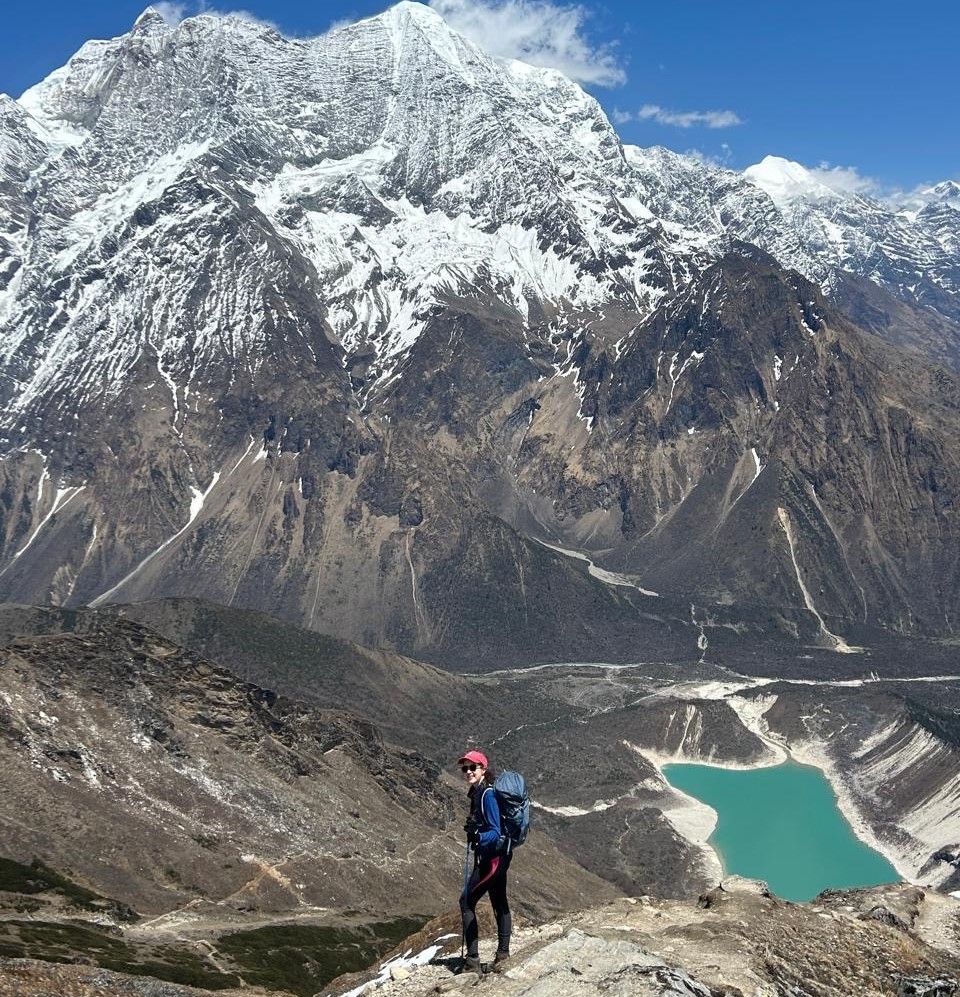
Stay Hydrated
Being dehydrated could aggravate the symptoms of altitude sickness; therefore, you need to ensure that you are drinking enough water on your travels.
- Aim to get a minimum of 3 to 4 liters of fluid per day.
- Stay away from alcohol and limit your caffeine intake since both tend to aggravate dehydration.
- In cold weather, warm fluids such as soups or herbal teas make a better alternative.
Eat Small, Healthy Meals
High elevations could suppress hunger, but the additional physical labor requires energy.
- Eat light meals consisting primarily of carbohydrates that your body can easily digest.
- Heavy and oily foods with slow digestion are not advisable.
- Carry some energy bars, nuts, or dried fruits with you for snacking.
Listen to Your Body
Usually, if something is wrong, your body tells you.
- Do not ignore indications at high altitude, including headaches, nausea, loss of appetite, fatigue, etc.
- Never try to & tough it out, rest, hydrate, and descend if necessary.
- Always inform your guide or trekking partner about your symptoms.
Consider Prophylactic Medication (After Consultation with Your Doctor).
Some trekkers choose to take Acetazolamide (Diamox) to aid the process of acclimatization.
- It decreases AMS symptoms by promoting faster acclimatization.
- Start the intake 1 day before an ascent to 3,000m after consulting a physician.
- Know the side effects (like increased urination or tingling sensations).
Trek with a Licensed Guide
A licensed trekker is a much more experienced guide than just being a person who takes you to places; in this instance, he or she will take care of you if you ever get in trouble.
- They may be able to identify the early signs of altitude sickness and recommend the right course of action.
- They are versed in first-aid training and can assist you in case of emergencies by escorting you to safety, if need be.
Obey the "Climb High and Sleep Low" Policy.
- If possible, during the day, go a little higher and sleep a little lower.
- This enables your body to have a better time acclimatizing.
- Many trekking programs are designed this way to decrease the likelihood of AMS.
With these recommendations and your due diligence, you are equipped to make a successful trip through the Manaslu Circuit much more likely. After all, it is better to prevent rather than cure, especially in remote, high-altitude settings.
What to do in the event of altitude sickness
Being able to recognize the early indications of altitude sickness and reacting swiftly can prove critical while trekking across the Manaslu Circuit. If you or any of your fellow travelers begin showing symptoms such as headache, dizziness, nausea, loss of appetite, or fatigue, do not ignore it. Here is what you need to do:
Stop Ascending Immediately
The only rule about high altitudes is basic & Don't go higher if you're feeling unwell."
If you go higher, your condition may worsen rapidly. Thus, stay at the same altitude for at least 24 hours and watch how your symptoms progress.
Rest and Rehydrate
Hydration, food, and rest typically improve even the mildest of complaints. Drink warm fluids, do not take alcohol or smoke, and keep your body as warm as possible. However, you can continue cautiously trekking the next day—the next day, of course, only when symptom-free.
Descend if Symptoms Persist or worsen
If some symptoms do not disappear or worsen, such as breathlessness at rest, chest tightness, or confusion, complete descent is advocated, whether at night or in bad weather. A descent of just 500 to 1,000 meters could relieve symptoms dramatically.
Use Emergency Medication if Recommended
Diamox (acetazolamide) is a medication that may relieve mild symptoms or be used preventively. Under medical guidance, you can use dexamethasone or nifedipine in more serious conditions. Consult a doctor before your trek planning, though, and carry prescribed medication.
Seek medical assistance or evacuation
Emergency helicopter evacuation may be the only option in very bad cases, such as when symptoms occur in HAPE or HACE. This is why travel insurance covering high-altitude evacuation is so crucial before starting the trek. Local guides receive training to manage emergencies and assist in coordinating with others to carry out any rescue mission.
Proper preparation is key, but knowing how to respond when altitude sickness strikes is what enables you to stay safe in the wild. Don't try to "push through," listen to your body, and put your health first over summit goals.
In Conclusion
There are many right reasons for trekking if you are a trekking enthusiast, but the 13 Days Manaslu Circuit Trek can be one of the lifetime journeying experiences, offering you the untouched beauty of the Himalayas, cultural richness, and a journey into pure wilderness.
Unfortunately, the heights need to be respected and prepared for, and it should never be forgotten that altitude also requires awareness. Knowing altitude sickness, with a solid counter-strategy against it, makes the difference between a bad experience and a great one.
First of all, your safety is paramount; then trek with the best of the best and the most experienced professionals in this region, who will guide you step by step along the complete trail.
Ready to discover the gorgeous Manaslu Circuit away from the world's gaze but with an assurance of safety and confidence?
Reserve your place on the trek with Mount Glory Treks' experienced professional guides, thorough acclimatization plans, and your comfort comes first at Mount Glory Treks.
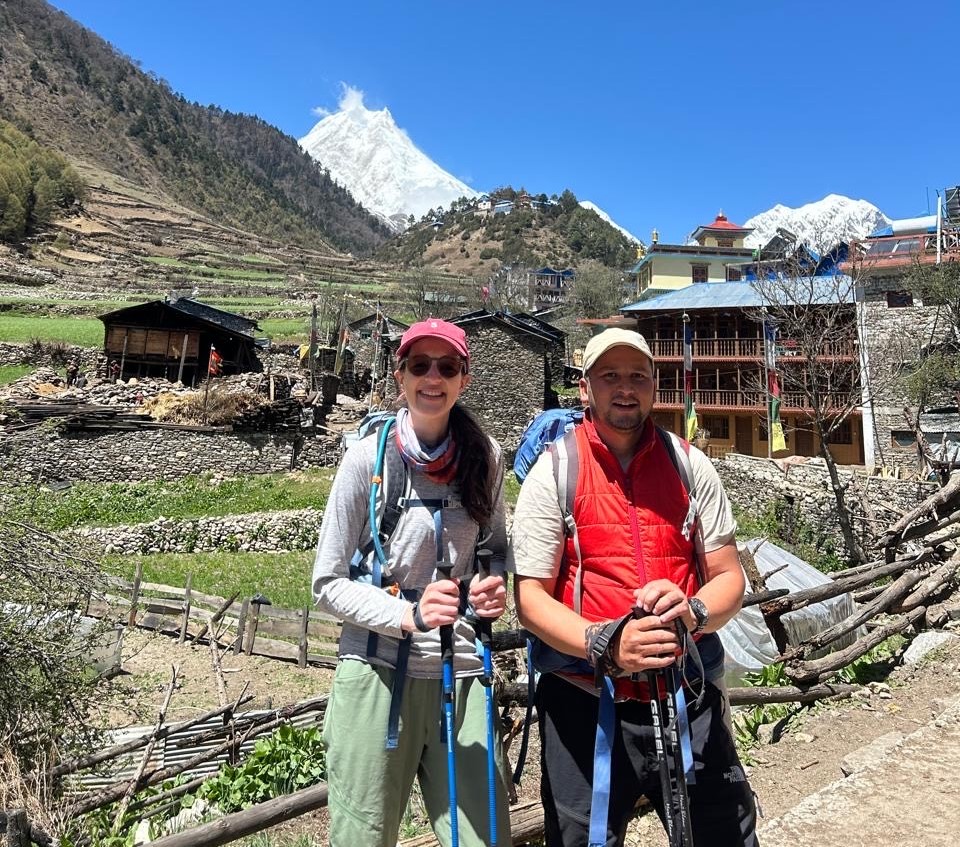



 3 reviews
3 reviews.webp)

